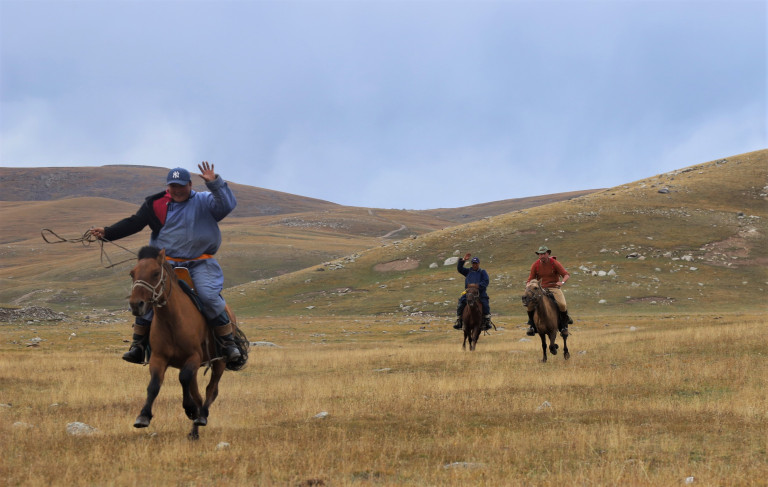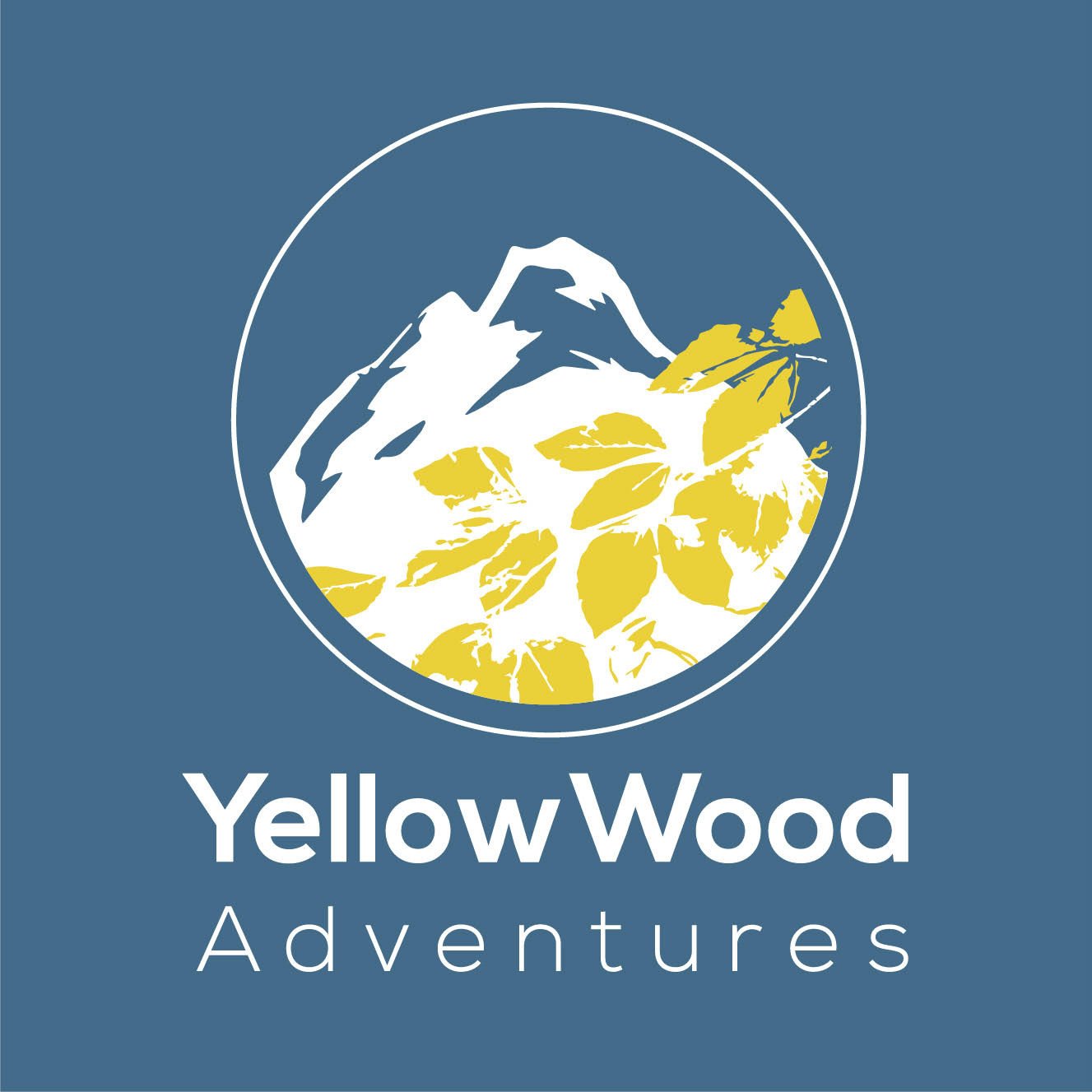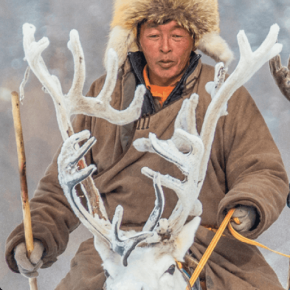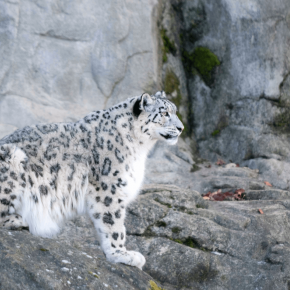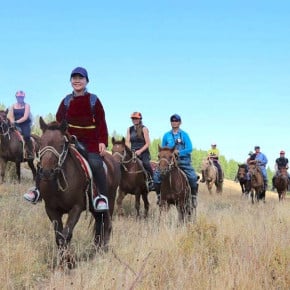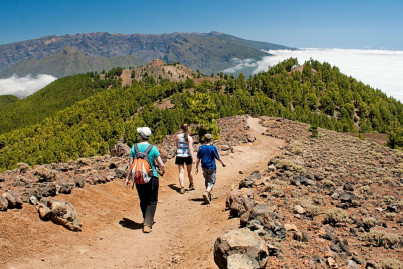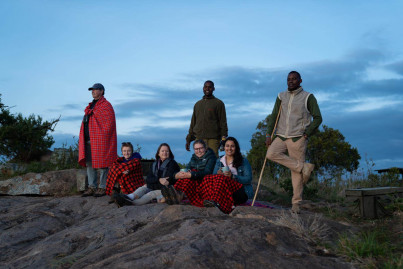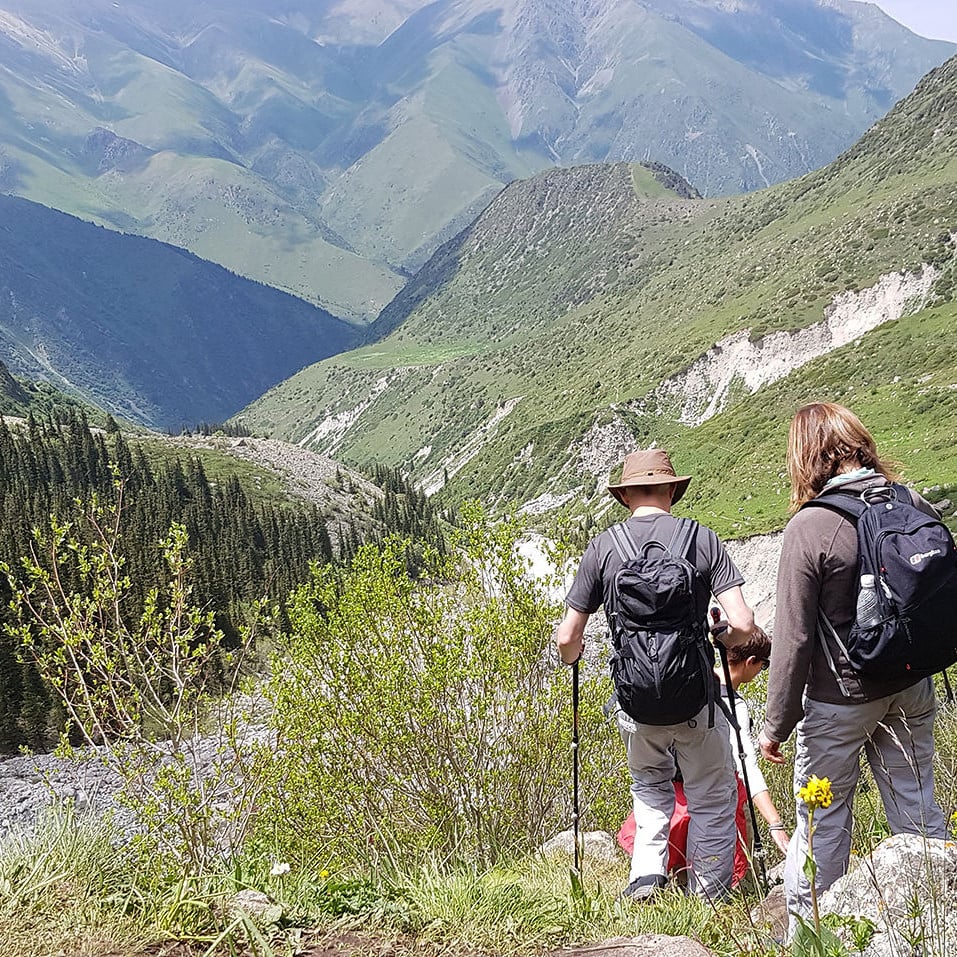“Lunch!” The heavy clumping of boots over crisp sun-dried grass woke me from a deep sleep. I was in my sleeping bag on a simple wooden bed and the book I had been reading had fallen face down onto my chest. I was in a large ger, the traditional round felt tents used for thousands of years by nomadic people, and all I wanted to do was sleep. As I pulled on my boots my eyes lazily roamed over the ornate array of family photos, keep- sakes, and a Tibetan Buddhist shrine. Delicate paintwork on orange wooden slats led up to the circular band of wood at the top of the roof, its canvas flap half open with the metal chimney from the woodstove poking out.
It was October and it had already been a hell of a year. The company was expanding rapidly and in the last couple of months I had been approaching burn-out as the constant manic pace of keeping up with everything had started to wear me down. This was the life I had always wanted but I hadn’t had a holiday in more than thirteen months, and I needed some space to regroup and recharge. Although this was technically a research trip, I was hoping it could double as some much- needed time out.
It had always been a dream of mine to go to Mongolia, but as I stepped outside, blinking into the dazzling sunlight of the steppe, and trudged over to the other ger, I didn’t even feel like I was here. My head was still buzzing with a thousand stresses and worries, cutting remarks people had made, and a general perspective of negativity that exhaustion tends to bring on, which the long sleepless flights from London and Moscow had done nothing to eradicate. After lunch I was back in my sleep- ing bag absorbed in my book until Mogi, my driver, popped his head through the door and indicated that we were going to go and drive somewhere. I couldn’t even remember what we were supposed to do that day. “OK I’m coming”.
Wild horses
I climbed into the passenger side of the Hyundai 4x4 and we sped off across the rolling brown plains. I had purposely chosen not to have an English-speaking guide and was especially glad of this now as we rode along in comfortable silence, the vast horizons hinting they could make some dent in the unseen whirligig of thoughts clouding my mind. It turned out we were driving into Khustai National Park to see wild horses known as takhi; the only wild horse to survive in modern times. It didn’t take long before we got up close to a herd, and we stepped out of the car into a biting wind to watch them silently going about their business. Also widely known as Przewalski Horses, their backs are a warm russet that fades to a light calico on their bellies and legs.
Their necks seemed more pronounced and the feeling I got from the herd was the same as being amongst a dazzle of Zebra in Kenya earlier that year where I had been leading a trip. At the time I had asked our Maasai guide: “Why did the Maasai never ride the Zebra?” He had just laughed and said: “You try getting on one”. Mogi indicated that I could walk up the steep hill to get closer to the herd if I wanted, so I took a bottle of water and started trudging up. Once I started moving in the sunshine, the wind lost its edge and I had to take my coat off. It felt good to be getting some exercise.
I gave the herd a wide berth because I had no experience with these wild animals and headed on up to a small summit. At the top I thankfully gulped in the cool air and stared out at the southerly blue/brown puttied waves of foothills thrown up en route to the horizon, which lead to China. It was only just now starting to sink in where I was. Mongolia is situated between Northern China and Russia’s Siberian tundra. In the west it is separated by just 50km from the border and the great swathes of Kazakhstan, whose people also used to be nomadic pastoralists, by the clamping jaws of China and Russia. Roughly speaking the natural topography of the country from north to south is in three bands: thick forest, steppe grasslands and the sandy deserts of the Gobi.
Tavai tolgoi mal
In Mongolia’s west the land rises to the Altai Mountains, which cradle the vast steppe of Central Asia all the way to the Carpathian Mountains in Ukraine, beyond which lies Hungary and the start of Europe. We were in Övörkhangai Aimag [Province] to the southwest of Töv Aimag, which houses Ulaanbaatar (Red Warrior), the huge sprawling capital city. The next day we were speeding down an asphalt road through more of the endless putty hills and plains full of horses and livestock. If a nomad owns tavai tolgoi mal [a five animal herd] of sheep, goat, camel, horse and yak/cattle he is considered wealthy. The lives of the nomads revolve around their livestock, which is the main reason for their life of constant movement; the never-ending need to find fresh pasture throughout the unforgiving seasons.
The sky was a bright clear blue and I was reading. We eventually pulled into the small town of Kharkhorin (also known as Karakorum) and stopped outside its museum. In the 13th Century Genghis Khan had united the Mongol tribes and exploded out of the country to create what would grow under his descendants to be the largest empire the world has ever seen, stretching from the Sea of Japan to the Danube in Hungary. He founded the cosmopolitan city of Kharkhorin as his capital although it was later moved to Peking by his grandson Kubilai Khan.
Just as impressive as the military prowess of the Mongols was the ability of their rulers to transition from conquering and pillaging to government and administration. The taxes levied by the empire were largely used to serve the diverse peoples they ruled, partly by promoting the arts. Highly tolerant of most religions, they created the first stable trade and communication routes across Eurasia which enabled the first direct relations between China and Europe. Still, you didn’t want to be on the conquering end of the machine when Mongol horsemen and their deadly arrows would destroy entire cities, slaughtering whole populations in order to instill fear and break the resolve to fight in the surrounding regions. In the 16th Century, Erdene Zuu Tibetan Buddhist Monastery was built on the ruins of the city.
Surrounded by monumental walls and 108 white stupas, beautifully preserved temples supported heavy sunken roofs of glazed tile and painted wood. Monks could be heard chanting with some standing around outside clad in their flowing robes in the cold sunshine, smoking. The spin of prayer wheels creaked in the wind and a few locals were seeking advice and teachings in a large ger. We drove further west in the morning off the asphalt road. We arrived at two gers and a nice lady called Sama greeted us with a blue scarf held out below a bowl of milk tea, which we both drank from, acknowledging her welcome.
She cooked tsuivan [meat with steamed noodles] over the wood-burning stove. Once we’d gulped down the food, a mute man who only communicated with hand gestures brought two stout horses for Mogi and I. Mogi, a 53-year old father of three, looked and dressed like a regular guy. But for our ride he’d donned a beautiful burgundy deel, the heavy finely-woven brocade overcoat that fastens at the shoulder and comes down to below the knee, with a bright yellow buss, the sash tied around the waist, and fine knee-high leather boots. The effect completely transformed him from a ‘Regular Joe’ into a proud, honourable man emanating an indefinable sense of calm. I noticed he carried himself differently in his deel as did all the local nomadic people I met, who often looked downright scruffy in their dirty Western clothing. Once they donned their deels (no matter how dirty or torn), they were transformed into timeless versions of their best selves.
Tuvkhun Monastery
Mogi spoke about 25 words of English and had begun teaching me Mongolian along the way to pass the time. There are two types of horses in Mongolia: one is nomkhon – quiet and good-natured, and the other is zhang hai – wild and fiery. It was evident within the first five minutes that my horse was a nomkhon – closely bordering on unconscious. He was also quite daban [fat] and I resigned myself to not having any real horsey fun on this ride. But it was no matter. Mogi led the way through a larch forest burning with autumn shades and we began to ascend a small rocky mountain, albeit the highest in the area. We tied our horses on a rope suspended between two trees and I immediately sensed that we had come to somewhere special.
We stood staring up at Tuvkhun Monastery, where Zanabazar, the head and founder of Mongolian Buddhism, had lived and created his famous artworks in the 16th Century. I took off my chaps and we walked up the rocky path to a small collection of temples. A man and a younger man and women were assembling a winter ger, washing the bright red painted wooden poles before constructing the framework. It was more the feeling of the place than the temples themselves that resonated with me. We climbed up to just below the top of the rock summit. There Mogi showed me the famous ‘cave of the womb’ and how to pull oneself into a minuscule crawlspace burrowed into the rock, turn around (with great difficulty) and then crawl out again to be ‘reborn’. I had crawled in a short way when claustrophobia hit me like a knife in the gut and I pulled straight out of there.
“Mogi, there is no way in The Lord’s holy trousers I’m going in there – let’s go up top.”
Mogi chuckled our way to the top and we walked onto the flat summit that had a round ovoo [cairn] of stones supporting a wooden pole with blue and yellow silk scarfs fluttering in the breeze. We walked around the ovoo three times, throwing loose rocks and pebbles back up onto the mound. The 360 degree view around us was of green turning gold larch trees growing in perfectly regulated straight lines, leading to rusty foothill rollers with cloud shadows moving across them.
We rode the horses back down to the gers and I watched two men from the camp, one on a horse and one on a motor- bike, corral their large flock of goats sprawled up one side of the valley. For the cattle and yaks, they just rounded up the young calves into a small pen close to the gers and the herd instinctively stayed around them. The many horses were added to the ever-growing herd as both the light and temperature began to plummet. I thought how wonderful it was that these species could cooperate with such serenity. This fantasy was rudely dis- banded almost immediately as the horses swiftly began booting and biting each other, the cattle and anything else within range. They didn’t settle down properly until it was fully dark.
Starry night
Later that night I wriggled out of my sleeping bag to take a pee in the night and gazed up in awe at the Milky Way sprawled majestically across the night sky, larger than my eyes could take in at once. I began to map out the constellations. To the north- west, Hercules danced like a hyperactive spider into the pots and pans of Ursa Major and Minor and the ‘North Star’ Polaris. Orion I deemed the ‘warrior lobster’ in the south. The five stars of Auriga I imagined as a boy-band because its brightest star is Capella. There was more: the great square of Pegasus; the twin stars Castor and Pollux of the Gemini constellation; and the ‘seven sisters’ of the Pleiades, the seven daughters of Atlas – the Titan of Greek mythology who holds up the sky. I couldn’t for the life of me pick out the jagged scrawl of Cassiopeia, but soon gave up because I got too cold and crawled back into bed.
After a short drive we reached where the Ulaan Tsutgalan River [Red Confluence] meets the Orkhon River in a roaring waterfall. It was here in the Orkhon valley that Ghengis Khan in 1204 as ruler of the eastern tribes of Mongolia defeated his powerful enemies in the west, the Naiman tribe, led by Tayang Khan. Although greatly outnumbered he employed tactics that would become associated with the Mongol Empire for centuries by ordering that every man light several bonfires at night to fool the enemy as to the true size of his army. He lured the Naimans to a pitched battle when Tayang’s son Kuchlug convinced his father that to retreat to the safety of the Altai Mountains would be an act of cowardice. Following this fatal decision, the Naimans were heavily defeated. At the age of 43 Genghis sat astride the banks of the Orkhon as the ruler of all the Mongol tribes, with the world at the feet of his horse.
It turned out that we didn’t really have much to do that day, so we drove out to a stretch of the river. As Mogi cast his fishing line into the milky waters, I sat on a warm stone in the sun with my head on my knees and read about the manifold atrocities inflicted upon the nomadic peoples of Central Asia, first by the Russian Empire, then the rise and fall of the Soviet Union. Mongolia, more than any other post-Soviet state, has been able to return to its nomadic heritage and way of life, which the USSR forcibly undertook to eradicate across the myriad Central Asian peoples. It was sobering reading.
A new guide
I was dozing off in our ger when Mogi came in with Bataa, my guide and horseman for the next four days. Aged 39 years old with high tanned cheekbones and a measured expres- sion, he was dressed in a splendid turquoise deel with a bright orange buss, over which he wore a high-collared silk Chinese jacket embroidered with gold dragons and a thick navy-blue Communist-style peaked cap with ‘Sport’ embossed on the side in copper. It was quite the entrance. Mogi and I had already consumed quite a lot of vodka that night but Bataa insisted that I play them a few tunes on my fiddle which I had brought with me. Where Mogi had an inquisitive mind when it came to the English language, Bataa had none. The only words I heard him utter in four days in the language were ‘yak’ and ‘ok’. This did nothing to prevent us getting along absolutely swimmingly.
In the morning Bataa and I set out on bay horses with a third black stallion with a white underbelly carrying my stuff strapped to its saddle across two equally weighted packs. Bataa slung the violin case over his chest like a warrior. My horse (which apparently had no name except ‘Mur’, which means ‘horse’ in Mongolian) was much more towards the zhang tai end of the spectrum and I could nudge him into a fast trot and eventually a canter. We headed up and away from the two rivers and Bataa immediately began to sing long, rolling melodious songs in a deep and resounding voice.
We crossed small rivers and trotted through valleys and stopped at his brother’s ger for lunch after a few hours. Bataa played with his newborn nephew. Arroz, a hardened cheese made from yak’s milk, was hung up with string around the ger and I ate a piece with my milk tea. At first it tasted like parmesan but then became increasingly bitter, I could barely finish it off and keep a straight face. Another couple pulled up on a motorbike with their young daughter and ate some bread. The wife had an incredibly white face and hands, which seemed very unusual, but there was no way I could try and comment on this without causing confusion and embarrassment, so I didn’t.
We rode on and were soon joined by Bataa’s dog Aslan. The Mongolian Bankhar breed of dog is an inseparable part of the nomadic herder’s life. They are very large, mostly black with brown and white patches, and act as guards to the family encampments – and sometimes as herders of the animals. A common greeting upon visiting a ger is nokhoi khorio (hold the dog). I like dogs as much as the next person but these dogs I absolutely loved and formed a strong bond with many I met along the way. Sometimes they were unbelievably playful and I found myself running around with them like a child. Riding a horse is always good but somehow having a Bankhar trotting alongside you completes the experience.
Into the wilderness
We threaded up through forest and the air became cool and patches of snow and ice appeared. A river cut a deep gash through the mountain rock on our left-hand side. Gold pine needles covered the snowy ground. Aslan kept stopping to root and sniff around but always kept up. We eventually came out into the open and I could see two snow-dusted depressions in the high mountain ahead of us. They sat beyond a snaking river that looked like a sun-bleached pelvis bone. I sure I’d seen this mountain previously in the distance from the Orkhon valley. Bataa’s gers overlooked this scene on a hill, with his yaks and goats grazing in the river valley below.
We tied up and untacked the horses then sat around the stove with Bataa’s wife Chuka, who had a very easy way about her, and ate fresh tarag (yoghurt). Propped against the TV was an old, slim bolt-action 22 rifle, that Bataa said he used to kill chun (wolf). After we had herded the goats and yaks and tied up the calves for the night, another lady came and sat with us and Bataa insisted I play the fiddle again. I gave them my best Irish jig but they weren’t impressed. Chuka mimed without a hint of irony the next day that I should leave the violin with her because such an awful racket would be effective for herding in the yaks in the evenings.
We set off into a cold, crisp late morning but had to dismount as soon as we started to climb the mountainside as it was too steep and icy, and the horses kept slipping. Bataa and I walked up the 45-degree slope leading our mounts and gulping in huge breaths of the icy air. I had four layers on and was pissing sweat under my clothes. We made good time however and walked them down the other side as well just to be safe. Remounting in the next valley, we fell back into the natural rhythm of things. Bataa started singing again, signalling all was well.
We reached a ger camp on a hill above Huis Nuur lake. We were now in the Naiman Nuur region made up of eight lakes of varying sizes. We were welcomed into a large ger by Dalban, a stout man with huge shoulders, arms and a belly to match, and his handsome wife Miga. Their son, Ochikdurch, oscillated between dark moods of silent broodiness and youthful good-naturedness like a good teenager. Aten Sarne, their pretty 16-year-old daughter was constantly laughing and smiling and had an open spirit. But the undisputed light of the family was three-year-old Onchiksurun, who ran around all day playing and making everyone laugh. We stayed with them for two nights.
Despite the previous evening’s woeful performance, Bataa insisted on bringing out my instrument again. This time, however, it was a big hit – largely because I stuck to ballads and let everyone have a go. Dalban and Miga painstakingly handmade delicious bortz (meat dumplings) steamed over a simmering basin of water on the central wood stove. Little Onchiksurun had found some Styrofoam packing cubes from somewhere which we used for a lengthy and uneven boxing match before settling down to some colouring in. I slept in a separate ger with a well-stocked burner that cast flickering shadows on the felt-supporting wooden slats of the roof. It was like sleeping in a giant Japanese lantern. I got up in the night to a waxing moon flooding the frozen lake and glistening mountains in its ethereal light. All the stars were hidden from view except ... Cassiopeia. “Ha! There you are, you sly witch!”
Family life
In the morning the women dressed in thick deels and set off to milk the yaks. They sat on tiny stools overlooking the lake and snow-dusted mountains. Dalban and his son let calves out of the pen where they had been secured for the night. He released them one at a time so they would run to their mothers and suckle. After a few minutes, when the milk was flowing, the calf would be tethered to the ground and the yak milk squeezed into a metal pail. The calf was then untethered to resume milking while another one was let out of the pen. It was a solid system. Bataa and I went riding in the afternoon for a few hours across the valley to some other lakes. On the way we saw a family dismantling their ger and packing it onto yaks to transport it down to the valley before winter arrived. Mongolian horses are small but very swift and we cantered them fast over uneven ground whooping like idiots.
That night the family made shimin arik or ‘Mongolian vodka’ – a spirit the strength of a strong wine made from mare’s milk. Once the milk has been turned into fermented yoghurt it is heated over the stove with a large tin drum placed around the basin. Within this is suspended a bucket and a second basin of cold water is placed over these. The alcohol evaporates from the yoghurt then condenses into the bucket off the cold basin in a pure liquid. We drank it hot watching Mongolian wrestling on TV and it tasted very much like Japanese sake.
The gers had cured goatskins spread out in the entrance- ways. Bankhar dogs lay sleeping curled up or spread out in the sun during the day after barking all night and blanched bones of all descriptions were strewn about the place. It felt like stepping into another time. In the morning Bataa and I led the horses to the lake, cracked the ice and let them drink. We tacked and packed up and then we were off again. It started to snow. Once across the valley we again climbed through another gilded forest.
The going was steep and the snow was thick on the ground. Soft flakes drifted slowly down settling on branches, and the air smelt like ice. The horses seemed to relish the cold and powered up at a steady pace. I gently realised that I felt completely at peace with myself and the world around me. Towards the top it started to get icy and I guided my mur over snow or rocks whenever I could. At one section we came upon what looked like a small pond of ice with no way around. “Hmm,” I distinctly remember thinking to myself, “I don’t like the look of that.”
No sooner had this gone through my mind that my mur slipped and fell onto his knees. As this happened in slow motion (as these things always seem to), I made sure I kicked out from my stirrups so I could roll harmlessly away to the side and not fall under him. We both scrambled back to our feet and I pushed him onto snow on the other side and got back on. Up ahead I could see that Bataa had dismounted, however, so I got off again and we led our horses up to the icy top where the view opened up to Naiman Nuur. The lake, through the snow, looked like a Norwegian fjord with steep white mountains rising from its edges and a long wooded peninsula sailing through its rippling waters to my right. We led the horses down close to its edge and remounted along the flat part of the trail before we began to climb again. As we did, the snow came in in a whiteout. By this time we had reached a vehicle track with only a few icy patches so we weren’t worried.
Both of us were singing as we reached the top (about 2,600m) and all of a sudden, Mogi was there with the parked Hyundi. We had hot coffee sitting inside laughing about the journey, which Bataa was about to backtrack with the horses. Is it madness to pursue such a convoluted journey for one fleeting moment of peace in a snowy forest far from home? Perhaps. But in my experience a person has to immerse themselves in nature for several days or weeks before it can really get to work on you. It takes time for the noise in our minds to declutter and be replaced by the natural rhythms of the earth.
I had assumed my portable solar charger had been either lost or stolen on this journey, but returning the following year with two groups of tourists, the Mongolian family looking after us presented it to me saying I had left it behind in one of their gers. It is a great bit of kit and had become an integral part of their lives – every member of the family using it to charge their phones on a daily basis as they have no fixed power source. I found it touching and unbelievably respectful that they had tried to return it to me nevertheless, which I of course refused.
This extract is taken from 'Wax & Gold: Journeys in Ethiopia & other roads less travelled' by Sam McManus:
